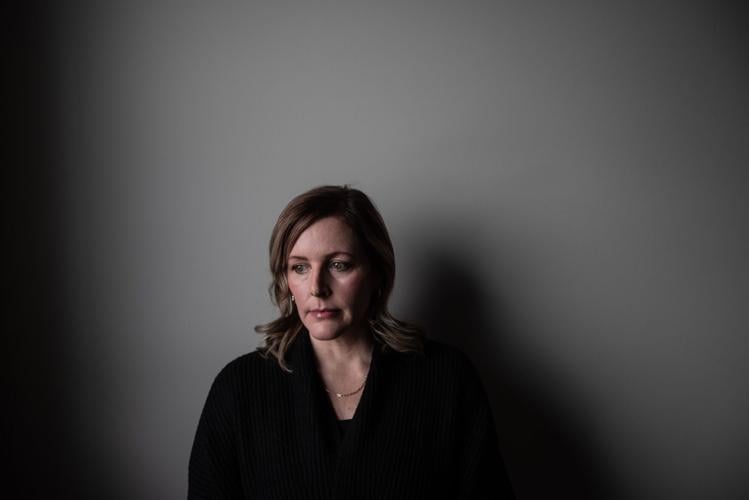When her 13-year-old daughter didnŌĆÖt show up on the school bus that brought her home everyday, Miranda Jordan-Smith felt frozen in place.
ŌĆ£It feels like you’re ŌĆ” out of your body watching some horrific crime show,ŌĆØ recalls the Edmonton mother.
Then panic set in, and she started searching.
She would not stop until the teen was found a week later in Portland, Ore., where F.B.I. agents stormed the hotel room of her abuser.
Noah Madrano, a 43-year-old Oregonian, had met the preteen from Alberta on an online chat site with no age verification or chat restrictions, said Jordan-Smith.
Beginning at the age of 12, the girl was ŌĆ£manipulated and groomedŌĆØ until she felt she was in a kind of relationship with someone who presented himself to her as a peer, said Jordan-Smith.
ŌĆ£All of the things that you would never want to happen to your child happened to our child.ŌĆØ
The Star is not naming the girl, who is a minor.
Jordan-Smith had set up restrictions on her daughterŌĆÖs devices and made efforts to monitor her usage and communications, she said. None of it was enough, and she is angry at how easily her daughter was victimized.
She has joined a growing chorus of upset parents calling for greater government oversight of online media to better protect children from predators.
As proposed federal legislation to address online victimization in Canada languishes in Parliament, Jordan-Smith and other advocates say lawmakers should be following the example of other countries that have already passed laws to better protect kids. She testified on Parliament Hill last month as the Standing Committee on Justice and Human Rights studied the proposal.
Spike in reports of online luring in Canada
CanadaŌĆÖs answer to the problem is detailed in the Online Harms Act, controversial proposed legislation that aims to hold social media companies responsible for content that sexually victimizes children, induces a child to harm themselves or spreads their intimate images without their consent.
The Liberal government first tabled the bill last February but made little progress thanks to push back from the Tory opposition and concerns from privacy advocates over the possible impacts to free speech protections.
With the recent prorogation of Parliament, the bill effectively dies unless it is reintroduced it in the next session.
ŌĆ£Words cannot describe the hurt, the frustration and worry as we will continue to lose children and more children will be victimized,ŌĆØ says Lianna McDonald, executive director of the Canadian Centre for Child Protection. ŌĆ£Canada must act immediately to regulate, as children canŌĆÖt wait.ŌĆØ

Lianna McDonald, executive director of the Canadian Centre for Child Protection, seen here in 2018.
Justin Tang/The Canadian PressIn the last several years, teens in B.C., Manitoba, New Brunswick and Prince Edward Island have died by suicide after being targeted by online sextortion schemes.
, a national tip line for online sexual abuse and child exploitation run by the Canadian Centre for Child Protection, receives an average of seven sextortion reports per day and has issued more than 40 million takedown notices for child sex imagery to more than 1,500 online service providers in 100 countries since 2017.
The tip line also saw a 242-per cent increase in online luring reports over the last three years.
Legislation would impose ‘duty to protect children’ on social media platforms
CanadaŌĆÖs proposed legislation ŌĆö the countryŌĆÖs most developed legislative response to the problem of online child exploitation to date ŌĆö would have imposed on social media platforms a ŌĆ£duty to protect children,ŌĆØ including removing and reporting ŌĆ£harmful contentŌĆØ that victimizes children.
Currently, social media platforms govern themselves when it comes to the tools and policies they employ to address child protection. Critics have alleged those responses have failed to address the problem, leading to calls for governments to step in with clear regulatory requirements.
The Canadian bill, if passed, would have also created a Digital Safety Commission with the power to enforce the new regulations.
Not only did it trigger warnings from Conservative leader Pierre Poilievre and civil liberties groups that the law would stifle free speech online, it raised concerns that it would impose overly harsh sentences that could violate Charter rights.
To break the parliamentary logjam, the government split off the more incendiary hate crimes provisions in early December from the regulations aimed at governing social media platforms.
The European Union, U.K. and Australia have already passed similar online safety legislation. Australian officials then went a step further in November, passing a law in November that effectively bans social media use by anyone under the age of 16.
Jordan-Smith, along with a group of other parents whose children have been victimized by online sexual predators, are calling on Canadian lawmakers to take action here.
ŌĆ£If the tech companies don’t get safeguards in place, all children are going to be highly exposed to sex and violence, suicide or being abducted,ŌĆØ says Jordan-Smith. ŌĆ£There are predators seasoned at doing this and they can get to your kid, too.ŌĆØ
If the Online Harms Act had been in place two years ago, Jordan-SmithŌĆÖs daughter would have been better protected, says Taylor Owen, founding director of the Centre of Media, Technology and Democracy at McGill University.
ŌĆ£Some of this risk would have been flagged via the mandatory risk assessments,ŌĆØ he said. ŌĆ£And (the online platform) would have had to put in place best practices for addressing that kind of harm, including taking down dangerous features such as adults being allowed to direct message children.ŌĆØ
The proposed legislation would have also required tools for reporting online violations of conduct, which could have prompted an ombudsperson investigation.
‘Grateful that our child is alive’
Jordan-SmithŌĆÖs daughter had a cellphone. But the mother says it had strict parental controls, her contacts were accessible to her parents and screen time was limited. The teen also wasnŌĆÖt allowed to use any of the major social media apps like Snapchat or Instagram.
ŌĆ£We had all the protection measures in place that you’re told to have in place ŌĆ” I would say more than a lot of (her) peers,ŌĆØ says Jordan-Smith.

Miranda Jordan-Smith remembers panic setting in when her 13-year-old daughter wasn’t on the school bus that brought her home everyday.
Jason Franson for the ║ŻĮŪ╔ńŪ°╣┘═°StarThe girl met the perpetrator using a device at school, said her mother.
U.S. Department of Justice officials allege Madrano travelled to Edmonton three times to meet his victim in person and sexually abused her in hotel rooms and video taped the incidents. He took her back to Oregon in the trunk of his vehicle ŌĆ£where he continued abusing her,ŌĆØ a DOJ statement reads.
On Jan. 13, Madrano pleaded guilty to sexual exploitation of a child and transportation of a minor with intent to engage in criminal sexual activity.
While she frantically searched for her daughter along with authorities in Canada and the U.S., Jordan-Smith got anonymous ransom notes demanding $25,000.
ŌĆ£Some crazy people were reaching out to us saying ŌĆ” if you don’t give us money by Sunday night we’re going to harvest her organs,ŌĆØ she said. ŌĆ£These platforms are not all being used for perhaps what they were intended by their makers ŌĆ” They’re being used to spread messages of hate and extortion.ŌĆØ
She had to review explicit images exploited teenage girls that police were sending Jordan-Smith.
ŌĆ£They would send it to me and say, ŌĆśIs this your child?ŌĆÖ Or I’d have to send pictures of my daughter in a swimsuit to them so they could try to learn her body type.ŌĆØ
By mid-week, she says she was quietly losing hope, coming to terms with the idea that her daughter had been taken and may well end up returning in a ŌĆ£body bag.ŌĆØ
ŌĆ£I’m not an overly religious person, but I can tell you I have talked to God ŌĆ” I remember the night just thinking, ‘Please, please, please, just let her come home. We need to know.’ And then the next morning, we found out that they found her.ŌĆØ
Jordan-Smith and other parents of children targeted by online predators were recently invited by the Canadian Centre for Child Protection to speak to lawmakers about their experiences and call for government oversight of criminal conduct online.
When they all met in Montreal to share their stories, Jordan-Smith learned some parents lost their children to suicide after online sexual extortion, threats and manipulation.
ŌĆ£We’re grateful that our child is alive. But we know that we have a lifetime of picking up the pieces.ŌĆØ
Her daughter has been in therapy ever since the kidnapping.
ŌĆ£We just listen whenever she’ll talk about incidents and sometimes, we have a cry over it. We just hold each other. We have to just go through it.ŌĆØ





























